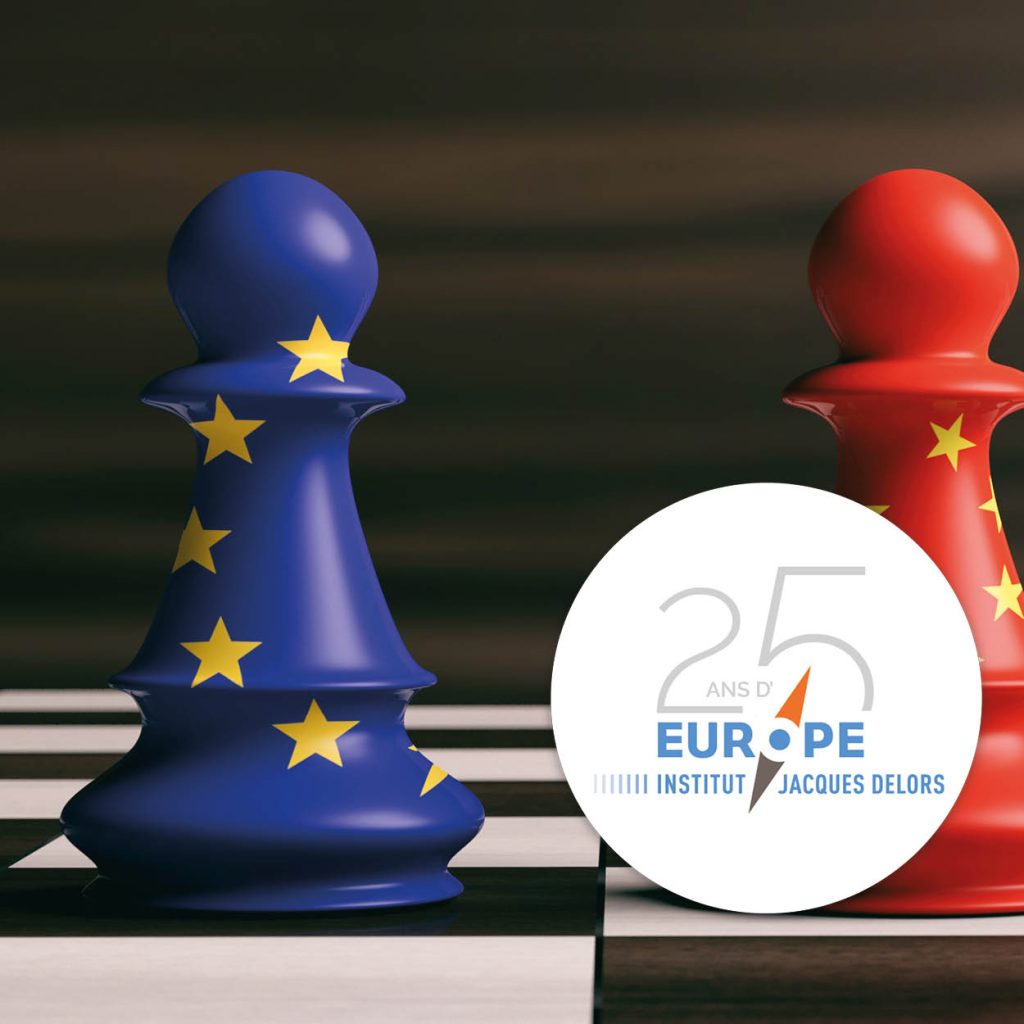Using the “Barnier Method”
to deal with China
By Elvire Fabry, senior researcher, Jacques Delors Institute

In the difficult negotiations with the United Kingdom, the cohesion and strategic coordination between EU Member States, as well as the leverage of the Single Market, were on full display. These assets should be exploited on other fronts.
Michel Barnier has won praise from across Europe for his leadership of the EU-27’s negotiation team during four and a half years of Brexit negotiations. Indeed, the ‘Barnier method’ has proven invaluable for the task; from his appointment, a few days after the June 2016 referendum, to the agreement on the United Kingdom’s withdrawal from the European Union on 24 January 2020 and, finally, the Trade and Cooperation Agreement on future relations that was signed on 30 December 2020. There was no precedent to deal with a country leaving the Union, so the former European commissioner and his team broke new ground (in particular Sabine Weyand, now heading the Commission’s Directorate-General for Trade). Instead of focusing exclusively on the bilateral negotiations with the United Kingdom, they ensured from the outset that the negotiations were backed with strong political support from the Member States.
This was necessary to prevent divisions between Member States from weakening the negotiating position with London. In their strategy, Barnier and his team played a proactive role to build European cohesion beyond the negotiating mandate. Ultimately, the December 2020 agreement was ratified by the Council over the course of a weekend. This was only possible because of the trust that had been established between the task force and the Member States.
It is useful to study the ‘Barnier method’ because there is another pressing issue for the EU-27: how to strengthen the Union’s cohesion vis-à-vis China. For the past two years, the European Commission has been actively trying to level the playing field with China. However, so far, there is not enough political support for this strategy from EU Member States, notably amongst business, administrative elites and civil society–particular beyond the capitals. There is not yet a European consensus on which policy should be pursued, which is perhaps reflected by China being simultaneously labelled ‘cooperation partner’, ‘economic competitor’ and ‘systemic rival’. The lively debate that was sparked by the signing of the EU-China Comprehensive Agreement on Investment (CAI) on 30 December 2020 also bears witness to this. A lack of cohesion could become even more problematic, as the Biden Administration is opening up new avenues for transatlantic cooperation on China, which has also revived the debate on the Union’s strategic autonomy.
Beijing recently organised a new summit of the so-called ‘17+1’ to strengthen ties with twelve EU Member States and counter transatlantic rapprochement. [1] However, at the meeting on 9 February, only six of twelve heads of state from the grouping’s EU members were present alongside Xi Jinping. This sends an encouraging signal of growing distance. To prevent the emerging conflict between China and the US from dividing the EU, a swift initiative is needed to forge a lasting consensus among the EU-27 on how to defend their interests.
What can we learn from the ‘Barnier method’? Three priorities were decisive in the conduct of the Brexit negotiations: building trust through transparency, coordinating a strategic vision, and defending the Single Market so that it can be fully leveraged at the global level.
Transparency creates a community of interest
Negotiations are always conducted in a mix of secrecy and transparency. Indeed, the publication of the Commission’s negotiating mandates was only slowly accepted by all Member States. Previously, an episode of civil society pressure in autumn 2014 made public the negotiating mandate for the Transatlantic Trade and Investment Agreement (TTIP), which set a precedent for subsequent negotiations under Jean-Claude Juncker.
Michel Barnier developed a method that was based on transparency. He did not confine himself to the official procedures to coordinate negotiating positions with Member States before and after trade talks and to keep the European Parliament regularly informed of the activities. Instead, he also disclosed a large number of negotiation-related documents on the Commission’s website, which enhanced transparency–as did, perhaps even more importantly, a permanent dialogue with stakeholders in the Member States. The ‘Barnier method’ was to not delegate ‘Brexit pedagogy’ to the Member States.
For more than four years, Barnier regularly went to all Member States. He engaged in dialogue, not only with the government officials in charge of the Brexit dossier, but also with parliamentarians, trade unions, business associations and other representatives of civil society.
His aim was to explain and remind people of the principles on which the European position was based. On the one hand, he was clarifying his method, i.e. to impose a sequencing of the negotiation on the United Kingdom: no negotiations before London activated Article 50 TEU and settlement on the withdrawal from the EU before any discussion on future relations. On the other hand, he recalled the key objectives: protecting the Single Market by refusing any cherry picking and instead balancing between benefit and cost; as well as reducing the risk of unfair competitor at the EU’s doorstep by putting in place guarantees for a level playing field.
It took a lot of time and energy for the chief negotiator, reportedly inspired by the ‘Delors method’, to make such an effort for transparency and pedagogy. Hammering out the red lines and principles of negotiation from the outset helped him to establish collective discipline among the Member States to prevent the risk of parallel negotiations between the United Kingdom and individual Member States.
It is clear that the ‘Barnier method’ succeeded in attracting the support of both governments and stakeholders at many levels of society. This cohesion was instrumental when the British government mobilised its embassies in European capitals to convince Member States that they should pursue their own interests. In the end, a large part of the public followed the evolution of the Brexit discussions less and less closely–no doubt because the voting drama in the House of Commons came to an end in 2019. In addition to this weariness and the urgency of managing the pandemic, the trust established by Barnier’s team made it possible to be less vigilant about the evolution of the negotiations.
Moreover, cohesion among the twenty-seven Member States on the Brexit issues was fostered by the bird’s eye view from the task force. This made it possible to better identify the fundamental concerns of the EU-27, beyond sectoral or national interests.
A task force and one voice for strategic coordination
Trade issues have taken up a lot of space in the Brexit negotiations. But there were as many issues to deal with as there are areas of cooperation in the European Union, such as internal security, scientific research and transport, amongst many others. The task force was set up in the autumn of 2016 within the Commission. It coordinated the various aspects of the negotiations and worked closely with the Secretariat-General and Commission directorates, as well as the European External Action Service (EEAS). The members of the task force were able to call on the expertise of the different services with a right to draw information and analysis from the different directorates.
Although the name of the task force changed between the withdrawal phase and the preparation for future relations, there was little rotation in the team. When Sabine Weyand took up her new position in DG Trade in the spring of 2019, she could monitor the progress of the negotiations even more closely. The continuity provided by Michel Barnier’s leadership throughout the various stages of the negotiations was decisive. Negotiations were conducted under the direct authority of the Presidency of the European Commission and in close cooperation with the Secretariat-General. But apart from the last days of negotiations in December 2020, when the President of the European Commission and the President of the European Council intervened directly, Michel Barnier was the EU’s driving force on Brexit. This decision of the President of the European Commission, Jean-Claude Juncker, should be welcomed. He chose a political figure, a former minister and, above all, a former European Commissioner, who was already well-known throughout Europe. His strong involvement ensured a coherent position–over time, during the bilateral negotiations with London, and within the EU. This allowed Europe to truly speak with one voice.
The EU should therefore retain the ‘Barnier method’, the holistic strategic approach that elevates negotiations to the level of the Single Market.
Leveraging the weight of the Single Market
Under the ‘Barnier method’, the divorce between the United Kingdom and the European Union became a public education exercise on the lived reality of the European project. It was critical to make the achievements of the last decades tangible, because the criticism of the Brexiters could have echoed on the continent. But most importantly, the Single Market, and the strong links between the Member States, were illustrated to European citizens, who learned about market rules, often down to the most technical details, such as the customs union, certification, conformity checks, tariff quotas, mutual recognition, equivalence, and rules of origin.
This has contributed to the constitutionalisation of the indivisibility of the four freedoms (i.e. the free movement of goods, services, capital and people). It has also helped to show that the harmonisation of European standards, often decried as an unnecessary constraint, has become a crucial factor for the competitiveness of European companies. This is especially true in view of the confrontation between the three leading standard setters–the United States, the European Union and China. The attractiveness of European standards, linked to the size of the Single Market, becomes even more strategic when considering China’s ambition to promote its standards.
Brexit has had an existential impact on the EU-27, as it called the fundamental purpose of their Union into question. But the defence of the collective interest, highlighted by the ‘Barnier method’, helps to provide a political narrative for the sectoral technical initiatives, carried out by the Commission under a mandate from the Member States, which resulted in the current European Union. By clarifying the founding principles of the Single Market and offering a strategy to defend it against distortions of competition, the Brexit negotiations were a successful experiment in defending European interests. In the final agreement, there is a particularly interesting chapter on preserving fair competition in connection with state aid to prevent lower levels of protection than current European environmental, social and climate standards. [2] Depending on the issues at stake, sanction or rebalancing measures will be applicable if the UK attempts to diverge from European regulations to such an extent as to have a significant impact on the Single Market. Not only has there been no concession on the rules of the Single Market (e.g. the lack of a guarantee on regulatory alignment has necessitated the return of border controls; more access to the benefits of mutual recognition for professional qualifications); but the limited access to the Single Market, which the British must now be content with, is subject to scrupulous vigilance.
Transferable lessons for dealing with China
When dealing with China as an economic partner and systemic rival, a strategic approach to the Single Market is critical. A good example is the coordination of foreign direct investment (FDI) controls that was established at the European level in October 2020. It is not the enough to assess the impact of an investment in a particular port or a Member State. Widening the aperture, we can see that by 2019 China had already obtained a majority stake in six of fourteen European ports.[3]
Such a bird’s eye view in the task force format would be even more useful to avoid the silo treatment of various issues in the bilateral relationship with China. Admittedly, most task forces are designed to be temporary. They correspond, as was the case with Brexit, to the urgency of a process that has to be completed. However, in the current geopolitical context, where the balance of power depends on three major powers–the United States, Europe and China–the creation of a task force on China within the European Commission would help to clarify the strategy for defending European interests.
It may have come to the surprise of some observers, that the ‘Barnier method’ facilitated cohesion during the Brexit negotiations. But the newfound ability to come to a collective position must now be channelled to construct a European consensus on the relationship with China.
The new Biden administration also presents an opportunity to rebuild a consensus position on the terms of transatlantic cooperation. The close ties between the EU and the US are not in question, but the modalities of cooperation are: will it take place under Washington’s leadership or will it be coordinated by both sides and with Brussels at eye level? Many countries other than China, and various important issues, could justify an effort of coordination and dialogue in the Member States. However, China’s economic power has increased so significantly that the pressure its state capitalism and surveillance systems exerts on liberal democracies and the multilateral system justify rapid mobilisation. While Europe needs to cooperate with Beijing in the fight against the pandemic and climate change, it is also in an intensifying rivalry over human rights, technological innovation and economic interests. The EU has to clarify the outlines of its strategy.
The European Commission is already implementing a strategy to level the playing field, which is so far only poorly understood by political and economic actors in the Member States. In order to strengthen the political support for this strategy, there must be more active dialogue within the Union, involving all stakeholders on a frequent basis.
The European Council, in its 22 May 2018 conclusion, promised greater transparency on the progress and content of the trade agreements under negotiation for all interested stakeholders, including national parliaments and civil society. The Commission’s Directorate-General for Trade has improved the flow of information and the dialogue with stakeholders in the Member States. The February 2021 Trade Policy Review once again underlines the need for more dialogue.
But the critical reactions to the investment agreement with China, first and foremost a rebalancing exercise to improve the Single Market’s defences, indicate that more dialogue would have been necessary at much earlier stages. Moreover, dialogue should not be limited to foreign investment issues. The agreement is only one instrument in a much broader arsenal that the European Commission is deploying vis-à-vis China to defend the Single Market and to fight against competitive distortions from Chinese state capitalism. The coordination of all the instruments that Europeans mobilise in their relationship with China (including industrial policy, as well as research and development), both for the Single Market and in the Member States, would merit a long-term dialogue between the head of a ‘Task Force on China’ and national as well as sub-national stakeholders. This would help provide the Union’s policy towards China with heft. Such a dialogue would lead to greater transparency on the initiatives that China is pursuing with individual Member States and provide an overview of China’s engagement in the Single Market. This long-term investment would strengthen European cohesion and allow the EU-27 to bring the full weight of the Single Market to bear on the international stage.
[1] The EU member states taking part in this initiative are Bulgaria, Croatia, Czech Republic, Estonia, Greece, Hungary, Latvia, Lithuania, Poland, Romania, Slovakia and Slovenia.
[2] ‘Framing the state aid debate for the post-Covid era: the Brexit challenge’, Elvire Fabry, JDI, 12 October 2020.
[3] ‘The challenges of Chinese investment control in Europe’, Elvire Fabry and Jacopo Maria D’Andria, JDI, 6 February 2019.




